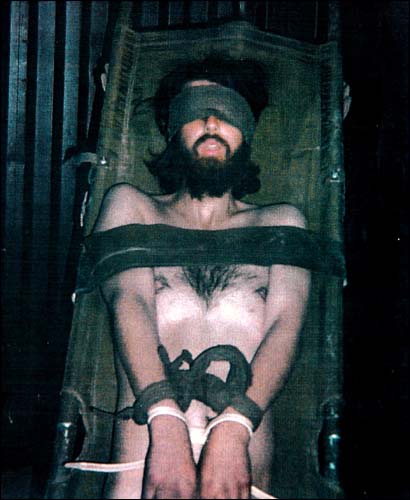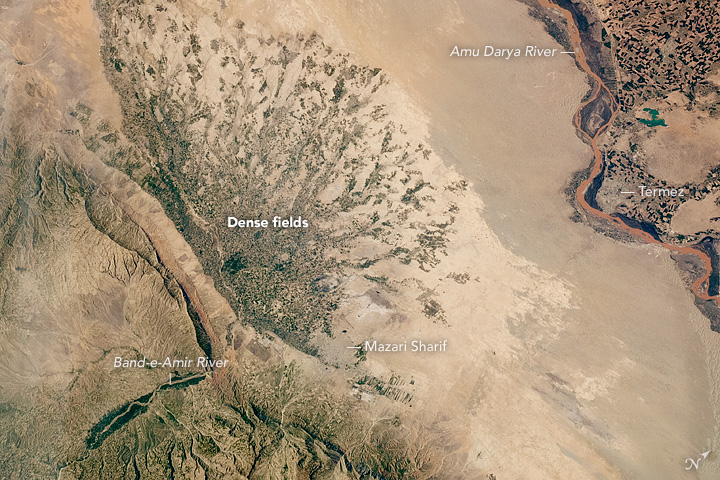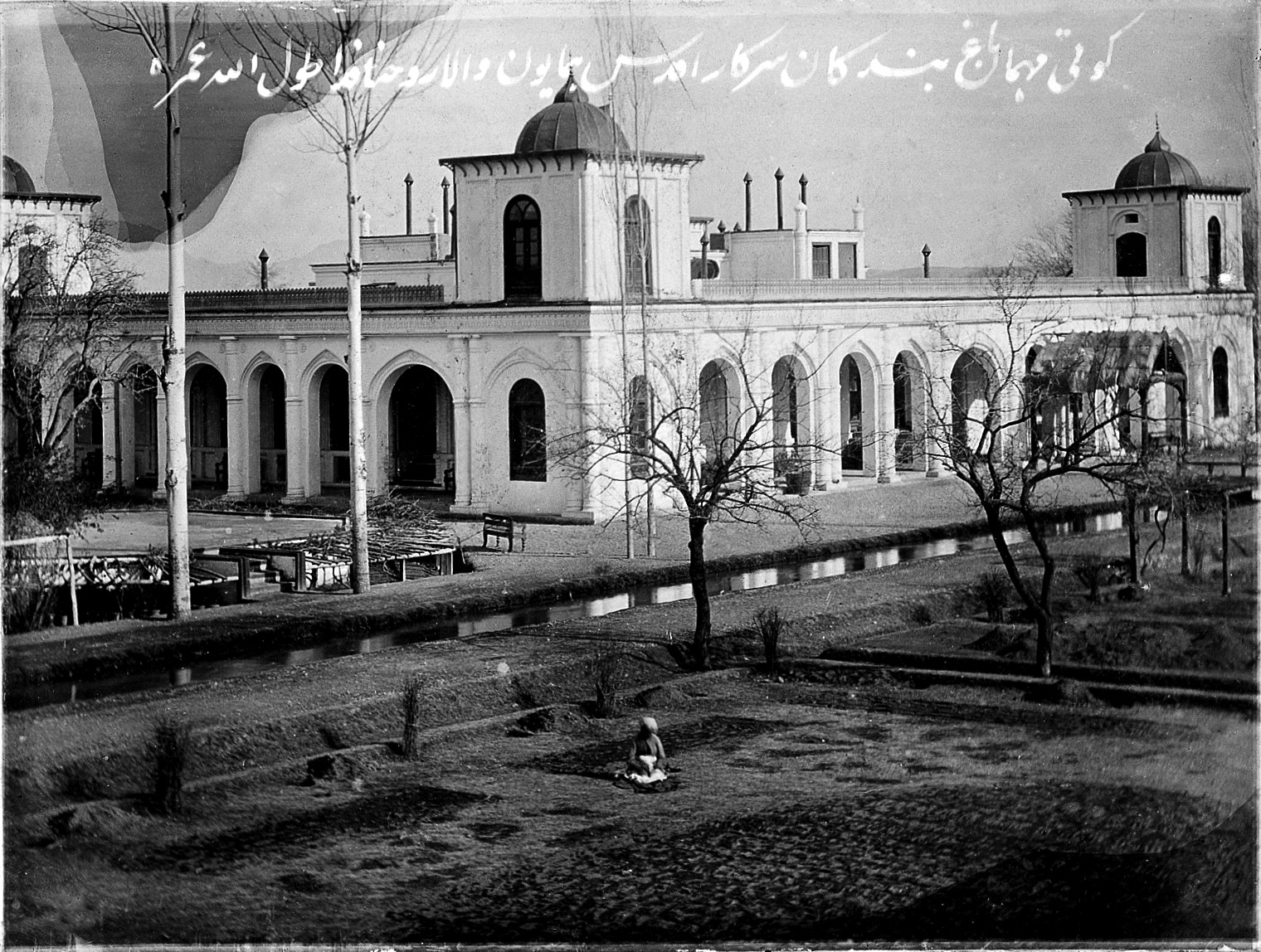|
Qala-i-Jangi
Qala-i-Jangi (Dari/Pashto: ) is a 19th-century fortress located near Mazar-i-Sharif in northern Afghanistan. It is known for being the site of a bloody 2001 Taliban uprising named the Battle of Qala-i-Jangi, in which at least 470 people were killed, including CIA agent Johnny "Mike" Spann. It served as Northern Alliance General Abdul Rashid Dostum's military garrison during the opening stages of the War in Afghanistan (2001–2021). History The fort was built in 1889 by Abdur Rahman, the 19th-century “Iron Amir,” the first ruler to unite Afghanistan. Then known as Dehdadi after the village nearby, it was built with British funds and intended both to defend against Russian invasion and to suppress revolts by Uzbek tribes. Rahman described it as "the largest and strongest fort that had ever been built in Afghanistan." It took 18,000 workers 12 years to complete it. In 1929, about 300 Russian troops were besieged inside the fort by 20,000 Turkmens. The name Qala-i-Jangi was prob ... [...More Info...] [...Related Items...] OR: [Wikipedia] [Google] [Baidu] |
Battle Of Qala-i-Jangi
The Battle of Qala-i-Jangi (sometimes also referred to as the "Battle of Mazar-i-Sharif") was a six-day military engagement following an uprising of prisoners-of-war on November 25, 2001. The battle took place between November 25 and December 1, 2001, in northern Afghanistan. It followed the intervention by United States-led coalition forces to overthrow the Taliban's Islamic Emirate of Afghanistan, which had been harboring al-Qaeda operatives. More than 400 foreign fighters surrendered outside Mazar-i-Sharif and were held at Qala-i-Jangi fortress by the Afghan Northern Alliance forces, where they were interrogated by Abdul Rashid Dostum's intelligence officers and Central Intelligence Agency (CIA) personnel hunting al-Qaeda suspects. The prisoners, who had not been searched properly when they surrendered, violently revolted and the ensuing fighting escalated into one of the bloodiest engagements of the conflict. It took Northern Alliance fighters, assisted by British and Americ ... [...More Info...] [...Related Items...] OR: [Wikipedia] [Google] [Baidu] |
Johnny Micheal Spann
Johnny Micheal "Mike" Spann (March 1, 1969 – November 25, 2001) was an American paramilitary officer in the Central Intelligence Agency's Special Activities Division. Spann was the first American killed in action, killed in combat during the United States invasion of Afghanistan in 2001. He died at the Qala-i-Jangi fortress during an Battle of Qala-i-Jangi, al-Qaeda prisoner uprising. Early life Johnny Micheal Spann was from the small town of Winfield, Alabama, the son of real estate agent Johnny Spann and his wife Gail. His name was spelled Micheal because of his mother's Irish ancestry. Spann graduated in 1987 from Winfield City School District, Winfield City High School, where he played football. At 17, he earned his private pilot license and later became a certified rescue diver and parachutist. Military service In December 1991, while attending Auburn University, he joined the United States Marine Corps Reserve, Marine Corps Reserve. After graduating from Auburn with a ... [...More Info...] [...Related Items...] OR: [Wikipedia] [Google] [Baidu] |
Abdul Rashid Dostum
Abdul Rashid Dostum ( ; prs, عبدالرشید دوستم; Uzbek Latin: , Uzbek Cyrillic: , ; born 25 March 1954) is an Afghan exiled politician, former Marshal in the Afghan National Army, founder and leader of the political party Junbish-e Milli. Dostum was a major army commander in the communist government during the Soviet–Afghan War, and in 2001 was the key indigenous ally to US Special Forces and the CIA during the campaign to topple the Taliban government. He is one of the most powerful and notorious warlords since the beginning of the Afghan wars, known for siding with winners during different wars. Born into an ethnic Uzbek peasant family in Jawzjan Province, Dostum joined the People's Democratic Party of Afghanistan (PDPA) as a teenager before enlisting in the Afghan National Army and training as a paratrooper, serving in his native region around Sheberghan. Soon with the start of the Soviet–Afghan War, Dostum commanded a KHAD militia and eventually gained a r ... [...More Info...] [...Related Items...] OR: [Wikipedia] [Google] [Baidu] |
Mazar-i-Sharif
, official_name = , settlement_type = City , image_skyline = , pushpin_map = Afghanistan#Bactria#West Asia , pushpin_label = Mazar-i-Sharif , pushpin_label_position = bottom , pushpin_mapsize = , pushpin_relief = yes , pushpin_map_caption = Location in Afghanistan , coordinates = , subdivision_type = Country , subdivision_name = Afghanistan , subdivision_type1 = Province , subdivision_type2 = District , subdivision_name1 = Balkh Province , subdivision_name2 = Mazar-i-Sharif District , established_title = , established_date = , leader_title = Mayor , leader_name = Abdullhaq Khurami , area_total_km2 = , area_land_km2 ... [...More Info...] [...Related Items...] OR: [Wikipedia] [Google] [Baidu] |
List Of Prisons In Afghanistan
There are approximately 77 prisons and detention facilities in Afghanistan, and at least one maximum security prison primarily for enemy combatants. The following is an incomplete list of prisons in Afghanistan: See also * Black jail * Do Ab prison * Mazari Sharif prison * Qala-i-Jangi * Rish Khor prison * Sheberghan Prison * Capital punishment in Afghanistan References {{Reflist, 30em External linksFor More Than 300 Afghan Children, Many Older Than 5, Home Is Mother’s Cellblock(New York Times, 23 Dec. 2017). Prisons Afghanistan Prisons A prison, also known as a jail, gaol (dated, standard English, Australian, and historically in Canada), penitentiary (American English and Canadian English), detention center (or detention centre outside the US), correction center, correcti ... ... [...More Info...] [...Related Items...] OR: [Wikipedia] [Google] [Baidu] |
120512-F-UZ487-059 (7260391402)
1 (one, unit, unity) is a number representing a single or the only entity. 1 is also a numerical digit and represents a single unit of counting or measurement. For example, a line segment of ''unit length'' is a line segment of length 1. In conventions of sign where zero is considered neither positive nor negative, 1 is the first and smallest positive integer. It is also sometimes considered the first of the infinite sequence of natural numbers, followed by 2, although by other definitions 1 is the second natural number, following 0. The fundamental mathematical property of 1 is to be a multiplicative identity, meaning that any number multiplied by 1 equals the same number. Most if not all properties of 1 can be deduced from this. In advanced mathematics, a multiplicative identity is often denoted 1, even if it is not a number. 1 is by convention not considered a prime number; this was not universally accepted until the mid-20th century. Additionally, 1 is the s ... [...More Info...] [...Related Items...] OR: [Wikipedia] [Google] [Baidu] |
Abdur Rahman Khan
Abdur Rahman Khan GCSI (Pashto/Dari: ) (between 1840 and 1844 – 1 October 1901) was Emir of Afghanistan from 1880 to his death in 1901. He is known for uniting the country after years of internal fighting and negotiation of the Durand Line Agreement with British India. Abdur Rahman Khan was the first child and only son of Mohammad Afzal Khan, and grandson of Dost Mohammad Khan, founder of the Barakzai dynasty. Abdur Rahman Khan re-established the writ of the Afghan government after the disarray that followed the second Anglo-Afghan war. He became known as ''The Iron Amir'' because his government was a military despotism. This despotism rested upon a well-appointed army and was administered through officials subservient to an inflexible will and controlled by a widespread system of espionage. The nickname, ''The Iron Amir'', is also associated due to his victory over a number of rebellions by various tribes who were led by his relatives. One source says that during his reign t ... [...More Info...] [...Related Items...] OR: [Wikipedia] [Google] [Baidu] |
Forts In Afghanistan
A fortification is a military construction or building designed for the defense of territories in warfare, and is also used to establish rule in a region during peacetime. The term is derived from Latin ''fortis'' ("strong") and ''facere'' ("to make"). From very early history to modern times, defensive walls have often been necessary for cities to survive in an ever-changing world of invasion and conquest. Some settlements in the Indus Valley civilization were the first small cities to be fortified. In ancient Greece, large stone walls had been built in Mycenaean Greece, such as the ancient site of Mycenae (famous for the huge stone blocks of its 'cyclopean' walls). A Greek '' phrourion'' was a fortified collection of buildings used as a military garrison, and is the equivalent of the Roman castellum or English fortress. These constructions mainly served the purpose of a watch tower, to guard certain roads, passes, and borders. Though smaller than a real fortress, they acted ... [...More Info...] [...Related Items...] OR: [Wikipedia] [Google] [Baidu] |
Archaeological Sites In Afghanistan
Archaeology or archeology is the scientific study of human activity through the recovery and analysis of material culture. The archaeological record consists of artifacts, architecture, biofacts or ecofacts, sites, and cultural landscapes. Archaeology can be considered both a social science and a branch of the humanities. It is usually considered an independent academic discipline, but may also be classified as part of anthropology (in North America – the four-field approach), history or geography. Archaeologists study human prehistory and history, from the development of the first stone tools at Lomekwi in East Africa 3.3 million years ago up until recent decades. Archaeology is distinct from palaeontology, which is the study of fossil remains. Archaeology is particularly important for learning about prehistoric societies, for which, by definition, there are no written records. Prehistory includes over 99% of the human past, from the Paleolithic until the advent of ... [...More Info...] [...Related Items...] OR: [Wikipedia] [Google] [Baidu] |
Soviet Union
The Soviet Union,. officially the Union of Soviet Socialist Republics. (USSR),. was a transcontinental country that spanned much of Eurasia from 1922 to 1991. A flagship communist state, it was nominally a federal union of fifteen national republics; in practice, both its government and its economy were highly centralized until its final years. It was a one-party state governed by the Communist Party of the Soviet Union, with the city of Moscow serving as its capital as well as that of its largest and most populous republic: the Russian SFSR. Other major cities included Leningrad (Russian SFSR), Kiev (Ukrainian SSR), Minsk ( Byelorussian SSR), Tashkent (Uzbek SSR), Alma-Ata (Kazakh SSR), and Novosibirsk (Russian SFSR). It was the largest country in the world, covering over and spanning eleven time zones. The country's roots lay in the October Revolution of 1917, when the Bolsheviks, under the leadership of Vladimir Lenin, overthrew the Russian Provisional Government ... [...More Info...] [...Related Items...] OR: [Wikipedia] [Google] [Baidu] |
Pocket Books
Pocket Books is a division of Simon & Schuster that primarily publishes paperback books. History Pocket Books produced the first mass-market, pocket-sized paperback books in the United States in early 1939 and revolutionized the publishing industry. The German Albatross Books had pioneered the idea of a line of color-coded paperback editions in 1931 under Kurt Enoch, and Penguin Books in Britain had refined the idea in 1935 and had one million books in print by the following year. Pocket Books was founded by Richard L. Simon, M. Lincoln ("Max") Schuster and Leon Shimkin, partners of Simon & Schuster, along with Robert de Graff. In 1944, the founding owners sold the company to Marshall Field III, owner of the ''Chicago Sun'' newspaper. Following Field's death, in 1957, Leon Shimkin, a Simon & Schuster partner, and James M. Jacobson bought Pocket Books for $5 million. Simon & Schuster acquired Pocket in 1966. Penguin's success inspired entrepreneur Robert de Graff, who partn ... [...More Info...] [...Related Items...] OR: [Wikipedia] [Google] [Baidu] |
Dehdadi
Dehdadi or Dihdadi is a town and seat of Dihdadi District in Balkh Province in northern Afghanistan.National Geospatial Intelligence Agency See also *Balkh Province Balkh (Dari: , ''Balx'') is one of the 34 provinces of Afghanistan, located in the north of the country. It is divided into 15 districts and has a population of about 1,509,183, which is multi-ethnic and mostly a Persian-speaking society. The c ... References Populated places in Balkh Province {{Balkh-geo-stub ... [...More Info...] [...Related Items...] OR: [Wikipedia] [Google] [Baidu] |
.jpg)





.jpg)